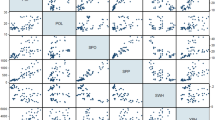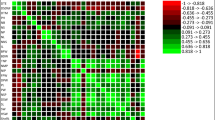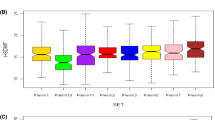Abstract
The phenotypic expression and heritability of quantitative traits vary due to genotypic differences, environmental influences and genotype by environment interactions. The objective of this study was to determine variance components and heritabilities of seed yield and its components in cowpea. Field experiments were conducted at three locations, three planting dates using ten diverse cowpea genotypes during 2004/2005. The experiments were laid out in the randomized complete block design with three replications. Results indicated significant interactions (P ≤ 0.01) among genotypes, locations and planting dates. The genotypic variance contributed ≥50% of the total phenotypic variance for the numbers of days to 50% flowering, seeds per pod, productive branches per plant and seed yield. The heritabilities of the numbers of days to 50% flowering were estimated at 50%, pods per plant (23%), days to maturity (66%), productive branches per plant (53%), 100 seed weight (11%) and seed yield (55%). The presence of considerable degree of genotypic variance among tested genotypes under various environments suggests that success in cowpea breeding could possibly be achieved through direct phenotypic selection.
Similar content being viewed by others
References
Agrobase (2005) Agrobase generation II user’s manual. Agronomix Software, Manitoba
Allen ON, Allen EK (1981) The Leguminosae: a source book of characteristics, uses and nodulation. The University of Wisconsin Press, Madison
Ayisi KK, Nkgapele RJ, Dakora FD (2000) Nodule formation and function in six varieties of cowpea (Vigna unguiculata L. Walp.) grown in a nitrogen rich soil in South Africa. Symbiosis 28:17–31
Becker HC (1988) Tests for crossover genotype-environmental interactions. Can J Plant Sci 68:405–410
Becker HC, Leon J (1988) Stability analysis in plant breeding. Plant Breed 101:1–23
Bradshaw AD (1965) Evolutionary significance of phenotypic plasticity in plants. Adv Genet 6:36–40
Coetzee JJ (1990) Cultural practices for cowpea. Farming in South Africa. Leaflet. AL. Directorate, Agricultural Information, Pretoria
Cooper M, Delacy IH (1994) Relationships among analytical methods used to study genotypic variation and genotype by environment interaction in plant breeding multi-environment experiments. Theor Appl Genet 88:561–572
Crossa J, Gauch HG, Zobel RW (1990) Additive main effects and multiplicative interaction of two international maize cultivar trials. Crop Sci 30:493–500
Damarany AM (1994) Estimates of genotypic and phenotypic correlation, heritability and potency of gene set in cowpea (Vigna unguiculata [L.] Walp). Assuit J Agric Sci 25:1–8
Dudley JW, Moll RH (1969) Interpretation and use of estimates of heritabilities and genetic variances in plant breeding. Crop Sci 9:257–262
Falconer DS (1964) Introduction to quantitative genetics. Oliver and Boyd, Edinburgh
Ishiyaku MF, Singh BB, Craufurd PQ (2005) Inheritance of time to flowering in cowpea (Vigna unguiculata (L.) Walp.). Euphytica 142:291–300
Mather K (1949) Biometrical genetics. Methuen, London
Mather K, Jinks JL (1971) Biometrical genetics, 2nd edn. Chapman and Hall, London
Ng O, Marachel R (1985) Cowpea taxonomy, origin, and germplasm. In: Singh SR, Rachie KO (eds) Cowpea research, production and utilization. Wiley, Chichester, UK, pp 11–21
Omoigui LO, Ishiyaku MF, Kamara AY, Alabi SO, Mohammed SG (2006) Genetic variability and heritability studies of some reproductive traits in cowpea (Vigna unguiculate (L.) Walp.). Afr J Biotechnol 5:1191–1195
SAS Institute (2004) Base SAS 9.1.3: procedures guide. SAS Institute, Cary
Singh BB, Ishiyaku MF (2000) Genetics of rough seed coat texture in cowpea. J Hered 91:170–174
Singh SR, Rachie KO (1985) Cowpea research, production and utilization. Wiley Interscience, Chichester
Singh, BB, Ehlers JD, Sharma B, Freire-Filho FR (2002) Recent progress in cowpea breeding. In: Fatokun CA, Tarawali SA, Singh BB, Kormawa PM, Tamo M (eds) Proceedings, world cowpea conference III, challenges and opportunities for enhancing sustainable cowpea production. IITA, Ibadan, Nigeria, pp 22–40
Snedecor GW, Cochran WG (1989) Statistical methods, 8th edn. Iowa State University Press, Ames
Van Ek GA, Henriet J, Blade SF, Singh BB (1997) Quantitative assessment of traditional cropping systems in the Sudan savanna of northern Nigeria II. Management of productivity of major cropping systems. Samaru J Agric Res 14:47–60
Xu NW, Shizhong Xu, Ehlers J (2009) Estimating the broad-sense heritability of early growth of cowpea. Int J Plant Genomics. doi:10.1155/2009/984521
Acknowledgments
The study was financially supported by the National Research Foundation (NRF) and the Agricultural Research Council (South Africa).
Author information
Authors and Affiliations
Corresponding author
Rights and permissions
About this article
Cite this article
Shimelis, H., Shiringani, R. Variance components and heritabilities of yield and agronomic traits among cowpea genotypes. Euphytica 176, 383–389 (2010). https://doi.org/10.1007/s10681-010-0222-z
Received:
Accepted:
Published:
Issue Date:
DOI: https://doi.org/10.1007/s10681-010-0222-z




